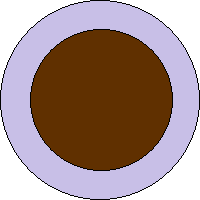K2-24
| K2-24 | ||
|---|---|---|
| 星座 | さそり座[1] | |
| 見かけの等級 (mv) | 11.068±0.110[2] | |
| 分類 | 恒星 | |
| 位置 元期:J2000 | ||
| 赤経 (RA, α) | 16h 10m 17.6977s[3] | |
| 赤緯 (Dec, δ) | −24° 59′ 25.261″[3] | |
| 視線速度 (Rv) | 1.18(32) km/s[3] | |
| 固有運動 (μ) | 赤経: −59.891(21) ミリ秒/年[3] 赤緯: −58.702(14) ミリ秒/年[3] | |
| 年周視差 (π) | 5.8273 ± 0.0169ミリ秒[3] (誤差0.3%) | |
| 距離 | 560 ± 2 光年[注 1] (171.6 ± 0.5 パーセク[注 1]) | |
| 軌道要素と性質 | ||
| 惑星の数 | 2 | |
| 物理的性質 | ||
| 半径 | 1.16±0.04 R☉[4] | |
| 質量 | 1.07±0.06 M☉[4] | |
| 表面重力 | 4.29±0.05 cgs[4] | |
| スペクトル分類 | G3V[5] | |
| 表面温度 | 5625±60 K[4] | |
| 金属量[Fe/H] | 0.34±0.04[4] | |
| 他のカタログでの名称 | ||
| EPIC 203771098、TYC 6784-837-1、2MASS J16101770-2459251[6] | ||
| ■Template (■ノート ■解説) ■Project | ||
K2-24(EPIC 203771098としても知られている)とは、地球からさそり座の方向に約560光年 (170 pc)離れた位置に存在する太陽よりも大きく質量も大きい金属が豊富なスペクトル分類がG3の主系列星である。2つの確認されたトランジットを起こす太陽系外惑星がこの恒星の周囲を公転していることが知られている[5]。W・M・ケック天文台で補償光学イメージングを使用してK2-24の伴星を検出する試みは否定的であったが[5]、デンマークに存在するラ・シヤ天文台の1.54メートル望遠鏡でラッキーイメージングを使用した後の観測では、K2-24から3.8秒角の距離で伴星の可能性がある天体が検出された。しかし、この候補天体はK2-24よりも8等級以上暗く、色温度が5400ケルビンであり、主系列星の結合された伴星とは矛盾している[7]。
惑星系
[編集]
Erik A. Petiguraとそのチームは、K2のCampaign 2領域の観測中にケプラー宇宙望遠鏡から得られたデータを分析し、惑星bとcの両方の発見と確認を報告した[5]。惑星の信号は、Andrew Vanderburgと共同研究者によって独立して検出された[8]。
この惑星系の2つの既知の惑星は、地球の5.4倍と7.5倍の半径を持っている。これにより、両方の惑星の半径が天王星と土星の半径の間に配置されることになる。これは、太陽系内には存在しない範囲である。公転周期は20.9日と42.4日で、惑星は2:1の平均運動共鳴の1%以内にある。観測された低い軌道離心率と軌道近くの共鳴は、惑星系の形成と進化に関する証拠を提供し、それらが原始惑星系円盤との重力相互作用から生じた可能性があることを示唆している。15.4地球質量を持つK2-24cは、より大きな惑星であるにもかかわらず、K2-24bの19地球質量よりも大幅に軽い。K2-24bの大気はその質量の26%を占め、K2-24cの大気は52%を占めると推定されている。核降着の現在のモデルは、惑星の質量のうち約50%の質量が大気に達したときに暴走降着が発生するはずであると予測している。これにより、K2-24cはそのモデルに対する潜在的な課題となっている[4]。
| 名称 (恒星に近い順) |
質量 | 軌道長半径 (天文単位) |
公転周期 (日) |
軌道離心率 | 軌道傾斜角 | 半径 |
|---|---|---|---|---|---|---|
| b | 19.0+2.2 −2.1 M⊕ |
0.154±0.002 | 20.88977+0.00034 −0.00035 |
0.06±0.01 | 89.25+0.49 −0.61° |
5.4±0.2 R⊕ |
| c | 15.4+1.9 −1.8 M⊕ |
0.247±0.004 | 42.3391±0.0012 | <0.05[9] | 89.76+0.18 −0.21° |
7.5±0.3 R⊕ |
脚注
[編集]注釈
[編集]出典
[編集]- ^ Roman, Nancy G. (1987). “Identification of a Constellation From a Position”. Publications of the Astronomical Society of the Pacific 99 (617): 695–699. Bibcode: 1987PASP...99..695R. doi:10.1086/132034. Vizier query form
- ^ Henden, A. A. et al. (2016). “VizieR Online Data Catalog: AAVSO Photometric All Sky Survey (APASS) DR9 (Henden+, 2016)”. VizieR On-line Data Catalog: II/336. Originally Published in: 2015AAS...22533616H 2336. Bibcode: 2016yCat.2336....0H. Vizier catalog entry
- ^ a b c d e f Brown, A. G. A. (2021). “Gaia Early Data Release 3: Summary of the contents and survey properties”. アストロノミー・アンド・アストロフィジックス 649: A1. arXiv:2012.01533. Bibcode: 2021A&A...649A...1G. doi:10.1051/0004-6361/202039657.
- ^ a b c d e f g Petigura, Erik A. et al. (2018). “Dynamics and Formation of the Near-resonant K2-24 System: Insights from Transit-timing Variations and Radial Velocities”. The Astronomical Journal 156 (3): 89. arXiv:1806.08959. Bibcode: 2018AJ....156...89P. doi:10.3847/1538-3881/aaceac.
- ^ a b c d e Petigura, Erik A. et al. (2016). “Two Transiting Low Density Sub-Saturns from K2”. The Astrophysical Journal 818 (1): 36. arXiv:1511.04497. Bibcode: 2016ApJ...818...36P. doi:10.3847/0004-637X/818/1/36.
- ^ "K2-24". SIMBAD. Centre de données astronomiques de Strasbourg. 2019年9月27日閲覧。
- ^ Evans, D. F. et al. (2018). “High-resolution Imaging of Transiting Extrasolar Planetary systems (HITEP). II. Lucky Imaging results from 2015 and 2016”. Astronomy and Astrophysics 610: A20. arXiv:1709.07476. Bibcode: 2018A&A...610A..20E. doi:10.1051/0004-6361/201731855.
- ^ Vanderburg, Andrew et al. (2016). “Planetary Candidates from the First Year of the K2 Mission”. The Astrophysical Journal Supplement Series 222 (1): 14. arXiv:1511.07820. Bibcode: 2016ApJS..222...14V. doi:10.3847/0067-0049/222/1/14.
- ^ Antoniadou, Kyriaki I.; Libert, Anne-Sophie (23 June 2020). “Exploiting periodic orbits as dynamical clues for Kepler and K2 systems”. Astronomy & Astrophysics 640: A55. arXiv:2006.12895. Bibcode: 2020A&A...640A..55A. doi:10.1051/0004-6361/202037779.